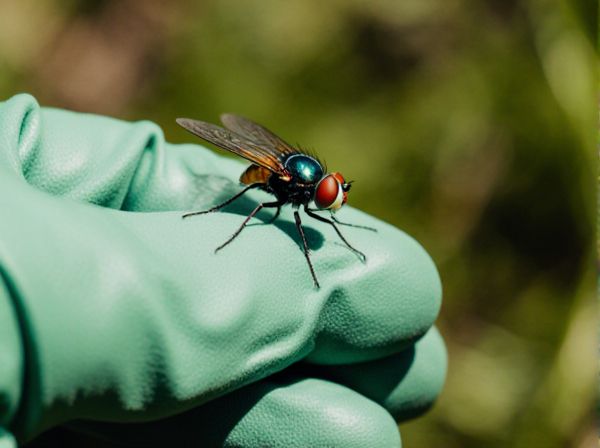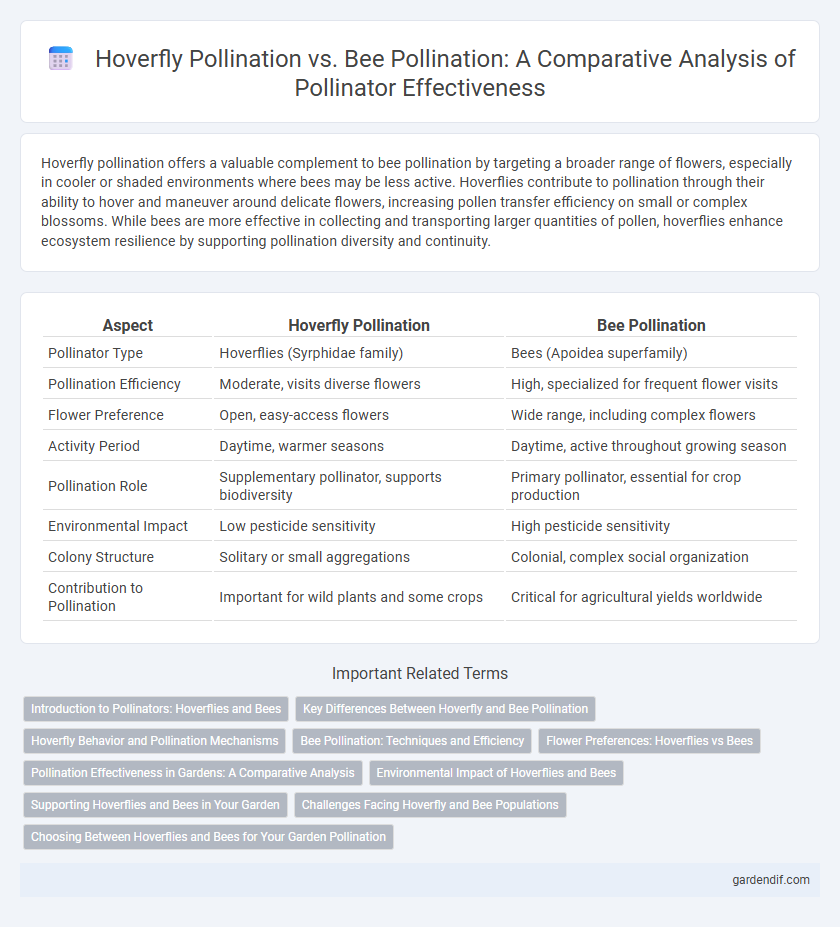
Hoverfly Pollination vs Bee Pollination Illustration
Hoverfly pollination offers a valuable complement to bee pollination by targeting a broader range of flowers, especially in cooler or shaded environments where bees may be less active. Hoverflies contribute to pollination through their ability to hover and maneuver around delicate flowers, increasing pollen transfer efficiency on small or complex blossoms. While bees are more effective in collecting and transporting larger quantities of pollen, hoverflies enhance ecosystem resilience by supporting pollination diversity and continuity.
Table of Comparison
| Aspect | Hoverfly Pollination | Bee Pollination |
|---|---|---|
| Pollinator Type | Hoverflies (Syrphidae family) | Bees (Apoidea superfamily) |
| Pollination Efficiency | Moderate, visits diverse flowers | High, specialized for frequent flower visits |
| Flower Preference | Open, easy-access flowers | Wide range, including complex flowers |
| Activity Period | Daytime, warmer seasons | Daytime, active throughout growing season |
| Pollination Role | Supplementary pollinator, supports biodiversity | Primary pollinator, essential for crop production |
| Environmental Impact | Low pesticide sensitivity | High pesticide sensitivity |
| Colony Structure | Solitary or small aggregations | Colonial, complex social organization |
| Contribution to Pollination | Important for wild plants and some crops | Critical for agricultural yields worldwide |
Introduction to Pollinators: Hoverflies and Bees
Hoverflies and bees are essential pollinators that contribute significantly to ecosystem health and agricultural productivity. Hoverflies, often mistaken for bees due to their similar appearance, perform pollination by transferring pollen while feeding on nectar, benefiting a wide range of flowering plants. Bees, including honeybees and bumblebees, exhibit specialized behaviors and physical adaptations that enhance pollen collection and distribution, making them highly efficient pollinators for diverse crops and wild flora.
Key Differences Between Hoverfly and Bee Pollination
Hoverfly pollination differs from bee pollination primarily in the species' foraging behavior and pollination efficiency; hoverflies typically visit a wider variety of flower shapes and sizes but transfer pollen less effectively than bees. Unlike bees, hoverflies do not collect pollen for offspring nourishment, resulting in more incidental pollen transfer rather than targeted pollination. Bee pollination involves specialized body structures like pollen baskets, enhancing pollen adherence and increasing pollination success compared to the smoother bodies of hoverflies.
Hoverfly Behavior and Pollination Mechanisms
Hoverflies exhibit a distinctive pollination behavior by hovering near flowers, allowing precise pollen transfer without landing, enhancing efficiency on delicate blossoms. Their ability to visit a wide range of flowers, including those less accessible to bees, broadens their role as pollinators in diverse ecosystems. Unlike bees, hoverflies utilize a combination of flight stability and rapid proboscis extension to collect nectar and pollen, supporting plant reproduction across various habitats.
Bee Pollination: Techniques and Efficiency
Bee pollination employs advanced foraging techniques such as flower constancy and efficient pollen transfer through specialized body hairs, resulting in higher pollination rates compared to hoverflies. Bees actively collect and distribute pollen across many flowers within a species, enhancing cross-pollination and crop yields. Their ability to communicate flower location through the waggle dance further optimizes pollination efficiency in agricultural ecosystems.
Flower Preferences: Hoverflies vs Bees
Hoverflies primarily visit flowers with open, shallow structures such as umbellifers and composite flowers, favoring easily accessible nectar and pollen sources. Bees prefer tubular or complex flowers like those in the Fabaceae and Lamiaceae families, which require specialized foraging behaviors. These distinct flower preferences influence pollination efficiency and plant reproductive success across different ecosystems.
Pollination Effectiveness in Gardens: A Comparative Analysis
Hoverfly pollination in gardens demonstrates notable efficiency due to their ability to visit a wide variety of flowers with rapid foraging behavior, making them effective pollinators for certain crops and ornamental plants. Bee pollination remains superior in terms of pollen transfer and flower constancy, especially among honeybees and bumblebees, ensuring higher rates of fruit and seed set. Comparative analysis reveals that while bees contribute to higher overall pollination effectiveness, hoverflies play a crucial complementary role, particularly in diverse garden ecosystems with a range of blooming periods.
Environmental Impact of Hoverflies and Bees
Hoverflies contribute significantly to pollination while offering lower environmental impacts due to their lifecycle relying less on flowers for nectar and their larvae often preying on pests, reducing pesticide use. Bees, particularly honeybees, provide robust pollination services but face challenges like habitat loss, pesticide exposure, and colony collapse disorder, which can lead to ecosystem imbalances. Supporting diverse pollinator populations, including hoverflies and bees, enhances ecosystem resilience and promotes sustainable agriculture practices.
Supporting Hoverflies and Bees in Your Garden
Hoverflies contribute significantly to pollination by visiting a wide variety of flowers, complementing the efforts of bees which are often more specialized in their floral choices. Supporting both hoverflies and bees in your garden can be achieved by planting diverse, native flowering plants that bloom at different times, providing continuous nectar and pollen sources. Creating habitats such as open ground for hoverfly larvae and undisturbed soil or bee hotels for solitary bees ensures their lifecycle needs are met, enhancing pollination efficiency and biodiversity.
Challenges Facing Hoverfly and Bee Populations
Hoverfly pollination faces challenges such as habitat loss, pesticide exposure, and climate change, which reduce their population and effectiveness as pollinators. Bee populations also suffer from similar threats, including colony collapse disorder, diseases like Varroa mite infestation, and environmental stressors that compromise their survival. Both pollinator groups are crucial for ecosystem health but require targeted conservation efforts to mitigate these ongoing challenges.
Choosing Between Hoverflies and Bees for Your Garden Pollination
Hoverflies and bees both play crucial roles in garden pollination, but selecting between them depends on your garden's specific needs and ecological balance. Hoverflies are excellent for pest control as their larvae feed on aphids, making them beneficial for integrated pest management alongside their pollination services. Bees, especially native species, tend to be more efficient pollinators for a wider variety of plants due to their specialized pollen-collecting behaviors and are essential for sustaining biodiversity in garden ecosystems.
Hoverfly Pollination vs Bee Pollination Infographic

 gardendif.com
gardendif.com